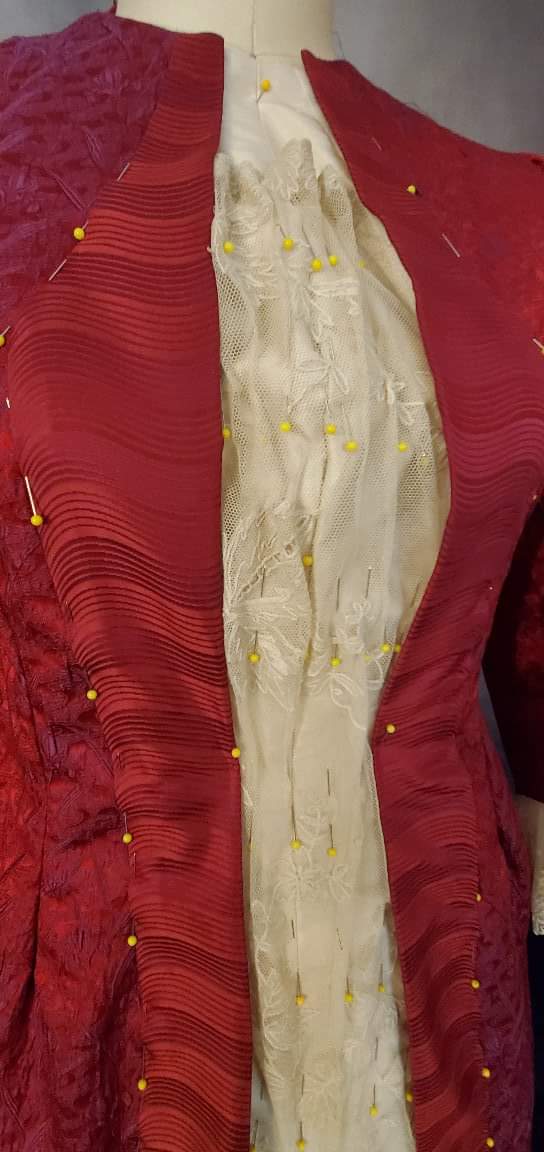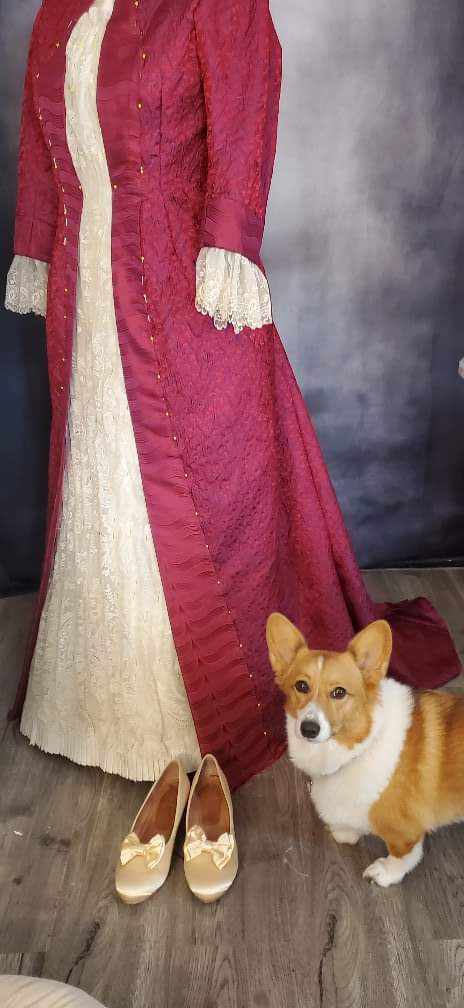As it was noted in yesterday’s post, the Aesthetic Movement, and more specifically Aesthetic Dress, arose in response to the predominant fashions of the Victorian Era and as such, sought to replace challenged convention in advocating for less structured and confining fashions. In all fashion movements, there’s always friction between competing trends and styles and advent of Aesthetic Dress was no exception; this friction is subtly captured in this 1881 painting by William Powell Frith:
This painting is a who’s who of British society and many notable people are depicted:

The annotated version…
For our purposes, what’s notable are the two groups of people in the front wearing aesthetic dress. Oscar Wilde is included with the right aesthetic dress group, speaking about the artwork. Also, behind the right group is a group of men reacting negatively to Oscar and his group. The painting was meant to be a caricature in that Frith had little regard for aesthetic dress nor Oscar Wilde, one of the aesthetic movement’s most vocal advocates. Frith explains in My Autobiography and Reminiscences, Vol. 2 (pp. 256-27):
Seven years ago certain ladies delighted to display themselves at public gatherings in what are called aesthetic dresses; in some cases the costumes were pretty enough, in others they seemed to rival each other in ugliness of form and oddity of colour. There were — and still are, I believe — preachers of aestheticism in dress; but I think, and hope, that the preaching is much less effective than it used to be. The contrast between the really beautiful costumes of some of the lady habituées of our private view, and the eccentric garments of others, together with the opportunity offered for portraits of eminent persons, suggested a subject for a picture, and I hastened to avail myself of it. Beyond the desire of recording for posterity the aesthetic craze as regards dress, I wished to hit the folly of listening to self-elected critics in matters of taste, whether in dress or art. I therefore planned a group, consisting of a well known apostle of the beautiful, with a herd of eager worshippers surrounding him. He is supposed to be explaining his theories to willing ears, taking some picture on the Academy walls for his text. A group of well-known artists are watching the scene.
The motivation for making this painting could simply be attributed to his simple dislike of Oscar Wilde (often referred to as “the apostle of the beautiful”) but it also reveals a reaction towards aesthetic dress and the aesthetic movement whose ideas ran counter to the structured realist painting style that was predominant in Victorian Britain. It certainly strikes us as modern readers as seemingly much ado about nothing- aesthetic dress was pretty innocuous and with its emphasis on unstructured movement, it did offer an alternative for women.
Sometimes it seems that there was some overlap between aesthetic dress and existing house dress and wrapper styles. Here’s one very simple example from circa 1881 that belonged to a one Annie Cronk, the daughter of a farmer and the wife of a railroad station agent, raised a family in rural Oregon, Wisconsin:
A few observations are in order- essentially this could be considered to be a house dress, that is a dress intended for wear around the house and not for going out in public (whether those norms were always observed is an interesting question in itself). This dress is primarily constructed from a red wool with a velvet collar; overall the dress has very little adornment, as what would be expected. Below is a picture of the dresse’s understructure:

House Dress, c. 1881; Wisconsin Historical Society (1952.128)
Here we see a structured underlayment that’s shaped and darted (and may even be boned); it’s not structured enough to act as a corset in its own right but there’s no doubt that the person wearing this garment would have had some sort of corset on underneath. Ultimately, while these styles pointed towards greater freedom of movement, there were limits. Also, it could be argued that this was simply a house dress chosen by Mrs. Cronk for utilitarian reasons and that the “aesthetic dress” considerations played no role in its creation but the silhouettes between all these garments are fairly similar and that except for differences in materials and degrees of decoration with lace and other trims. So, given that the basic silhouette of aesthetic dress and already existing house dress/wrappers were fairly similar, why the reaction? Our own theory is that it was more about these styles being worn in public than anything else but that’s just speculation on our part.
Ultimately, what we found compelling here is that we see a trend and a reaction before us in an explicit way and it’s interesting to watch the conflict develop. As a fashion trend, aesthetic dress didn’t last long; fundamental changes in women’s wear was another 20 years or so off with visionaries such as Paul Poiret. However, it’s a good illustration of how fashion trends and their reactions are often rooted in cultural conflicts.
Like this:
Like Loading...
























